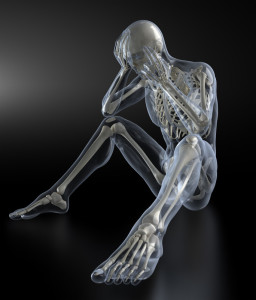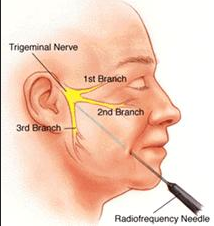FAQs of Facial Pain
 What is Facial Pain?
What is Facial Pain?

Facial pain often resembles a headache, but the pain is more severe, piercing and occurs within the facial region. While there are many causes for facial pain, the root and location of the pain may be difficult to find. Due to the diagnosing challenges, facial pain can be hard to treat.
The pain may occur around the eyes, near the nose and along either side of the mouth. Some cases result in facial pain lower on the face, along the jaw line or around the mouth.
If left untreated, facial pain may become chronic. Pain levels range from dull and throbbing to sharp and piercing, often tingling due to nerve damage. In some cases the pain won’t go away and little to no relief is provided without treatment.
What Causes Facial Pain?
There are a number of reasons for facial pain but the most common causes stem from migraine headaches with radiating pain into the face, dental problems such as TMJ that have not been remedied, and neuropathic facial pain like trigeminal neuralgia.
While it can be difficult to determine the source of pain, the goal of treatment is to diagnose as best as possible the root cause and eliminate painful symptoms associated with this kind of condition. Face pain can be debilitating and interfere with daily activities if relief is not found.
What Treatment Plans Help with Facial Pain?
Nerve blocks are one form of treatment that is highly effective in reducing facial pain. In all nerve block procedures for the face, a needle is used in various regions of the face to block nerve responses to pain. The procedures are designed to reduce or eliminate pain

Radiofrequency Ablation for Trigeminal Neuralgia
in the face.
Trigeminal block – This procedure is a nerve block that involves numbing the skin on the face. A needle is inserted into one side of the face and is performed with the aid of x-ray assistance (fluoroscopy).
This is a common procedure used to help diagnose where the pain is generated. If the procedure provides favorable results and pain is relieved then the patient may then receive an electrical current through a radiofrequency treatment procedure that is designed to provide pain relief for three to six months (Napenas, et al., Br Dent, 2011).
Ganglion block – Certain types of facial pain are responsive to a sphenopalantine ganglion block. This procedure is designed to numb a small group of nerves by placing a swab inside the nasal cavity. This procedure may provide temporary relief and if it is deemed a success and eliminates pain, then further procedures are discussed to keep the pain limited.
Here are some conditions where a sphenopalatine ganglion block works well:
- Atypical facial pain
- Head and neck cancer pain
- Acute and Cluster Headaches
- Herpes zoster pain (shingles)
- TMJ Pain (Temporomandibular Joint)
- Complex Regional Pain Syndrome (CRPS)
- Reflex Sympathetic Dystrophy (RSD)
- Sluder’s Neuralgia
- Vasomotor rhinitis
- Supraorbital and Supratrochlear block – This type of nerve block is conducted by using a needle to be inserted near the region of the eyebrow in order to numb the skin around the eyebrow and forehead. This type of nerve block allows pain specialists to diagnose the source of the facial pain.
Like most nerve blocks, this procedure is not permanent but does allow pain management doctors to locate the source area that leads to facial pain. By finding the source, pain management is more effective.
How Is Injury-Related Facial Pain Best Treated?
Non-trigeminal facial pain is a condition in which the sufferer experiences facial pain as a result of an injury or facial trauma. A combination of treatment is required to provide any form of relief for this type of condition. These patients may be treated with:
- Medications for pain relief
- Nerve block treatment

- Therapy and rehabilitation procedures
- Surgical release in the most severe cases
- Symptoms of facial pain can be debilitating and greatly impact a person’s daily activities. A pain management specialist can assist you in the treatment needed to relieve painful symptoms associated with this condition.
How Is Atypical Facial Pain Best Treated?
Atypical facial pain is a condition that affects the face and causes pain, while showing some signs of trigeminal neuralgia. The pain is often described as dull in nature, but can be frequent and ongoing. Aching, burning and sharp pains may be felt within the face. Atypical face pain may occur as a result of sinus or dental surgery and trauma to the face.
 Atypical facial pain is treated on a case-by-case basis, as every situation is unique. Some patients respond well to conservative treatment, such as medications or therapy, while others require nerve blocks to eliminate pain.
Atypical facial pain is treated on a case-by-case basis, as every situation is unique. Some patients respond well to conservative treatment, such as medications or therapy, while others require nerve blocks to eliminate pain.
Surgical and radiation treatments are reserved for the most severe cases of facial pain, but are effective in eliminating symptoms. Ask your pain doctor about the possible treatments available for facial pain if you experience symptoms that are severe enough to impact your daily activities.
What is the Prognosis of Facial Pain?
The most effective way to treat your face pain is to identify the source. Pay careful attention to any triggers or associated symptoms that may arise in combination with the facial pain. Migraines and TMJ often lead to facial pain, but relief is available. A patient does not have to live with chronic and debilitating facial pain.
Your pain management doctor can assist you in determining the best possible treatment plan. When anti-inflammatory medications and steroid injections fail, other options for pain relief may be available to reduce symptoms and allow you to carry out your routine activities.


